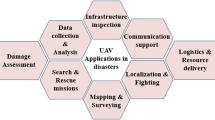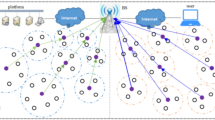Abstract
The authors have investigated the aspects of developing hybrid sensor networks as subsystems of environmental and emergency monitoring systems for critical infrastructure and analyzing their operability. They have proposed a hybrid sensor network architecture based on Edge Computing (EC) technology, which combines stationary and mobile components. The first component relies on a ground sensor network (GSN), and the second one comprises an unmanned aerial vehicle swarm forming a flying EC network. The authors have analyzed algorithms for data collection, scalability issues, and optimizing the operation of GSN and entire monitoring systems. Reliability models of GSN under conditions of failure of individual sensors or sensor groups are developed and investigated. The authors have obtained the analytical dependences of reliability indicators on the sizes of sensor failure clusters and their intensity. The authors have provided recommendations for designing and implementing hybrid sensor networks.
Similar content being viewed by others
References
P. David, V. Idasiak, and F. Kratz, “A sensor placement approach for the monitoring of indoor scenes,” in: G. Kortuem, J. Finney, R. Lea, and V. Sundramoorthy (eds.), Smart Sensing and Context, EuroSSC 2007, Lecture Notes in Computer Science, Vol. 4793, Springer, Berlin–Heidelberg (2007), pp. 110–125. https://doi.org/10.1007/978-3-540-75696-5_7.
K. A. Fasla and M. Anil, “A solar energy harvesting system for WSN node in industrial sectors,” Int. J. Eng. Res. Technol., Vol. 11, Iss. 06, 576–582 (2022). https://doi.org/10.17577/IJERTV11IS060270.
Y. Zhou, H. Qian, Q. Wang, and S. Li, “Performance modeling analysis of D-MSMR-CARQ with relay selection in wireless sensor networks,” Secur. Commun. Netw., Vol. 2021, 5533926 (2021). https://doi.org/https://doi.org/10.1155/2021/5533926.
V. P. Horbulin, L. F. Hulianytskyi, and I. V. Sergienko, “Optimization of UAV team routes in the presence of alternative and dynamic depots,” Cybern. Syst. Analysis, Vol. 56, No. 2, 195–203 (2020). https://doi.org/https://doi.org/10.1007/s10559-020-00235-8.
V. P. Horbulin, L. F. Hulianytskyi, and I. V. Sergienko, “Planning of logistics missions of the “UAV+vehicle” hybrid systems,” Cybern. Syst. Analysis, Vol. 59, No. 5, 733–742 (2023). https://doi.org/https://doi.org/10.1007/s10559-023-00609-8.
T. Arjannikov, S. Diemert, S. Ganti, and C. Lampman, “Using Markov chains to model sensor network reliability,” in: ARES’17: Proc. of the 12th Intern. Conf. on Availability, Reliability and Security (29 August – 01 September 2017, Reggio Calabria, Italy), Article No. 6, Association for Computing Machinery, New York (2017). pp. 1–10. https://doi.org/10.1145/3098954.3098979.
S. Chakraborty, N. K. Goyal, S. Mahapatra, and S. Soh, “A Monte-Carlo Markov chain approach for coverage-area reliability of mobile wireless sensor networks with multistate nodes,” Reliab. Eng. Syst. Saf., Vol. 193, 106712, 1–14 (2020). https://doi.org/https://doi.org/10.1016/j.ress.2019.106662.
D. Deif and Y. Gadallah, “A comprehensive wireless sensor network reliability metric for critical Internet of Things applications,” J. Wireless Com. Network, Vol. 145, 145 (2017). https://doi.org/https://doi.org/10.1186/s13638-017-0930-3.
M. Narang, S. Xiang, W. Liu, J. Gutierrez, L. Chiaraviglio, A. Sathiaseelan, and A. Merwaday, “UAV-assisted edge infrastructure for challenged networks,” in: 2017 IEEE Conf. on Computer Communications Workshops (INFOCOM WKSHPS), Atlanta, GA, USA (2017). pp. 60–65. https://doi.org/https://doi.org/10.1109/INFCOMW.2017.8116353.
N. Cheng, W. Xu, W. Shi, Y. Zhou, N. Lu, H. Zhou, and X. Shen, “Air-ground integrated mobile edge networks: Architecture, challenges, and opportunities,” IEEE Commun. Mag., Vol. 56, No. 8, 26–32 (2018). https://doi.org/https://doi.org/10.1109/MCOM.2018.1701092.
M. Catelani, L. Ciani, A. Bartolini, C. Del Rio, G. Guidi, and G. Patrizi, “Reliability analysis of wireless sensor network for smart farming applications,” Sensors, Vol. 21, Iss. 22, 7683 (2021). https://doi.org/10.3390/s21227683.
V. K. Akram, Z. A. Dagdeviren, O. Dagdeviren, and M. Challenger, “PINC: pickup non-critical node based k-connectivity restoration in wireless sensor networks,” Sensors, Vol. 21, Iss. 19, 6418 (2021). https://doi.org/10.3390/s21196418.
H. V. Fesenko and V. S. Kharchenko, “Reliability models of UAV fleet groups with k-out-of-n redundancy for monitoring of potentially dangerous objects,” Radioelectronic and Computer Systems, No. 2 (90), 147–156 (2019). https://doi.org/10.32620/reks.2019.2.14.
M. Kolisnyk, D. Kochkar, and V. Kharchenko, “Markov model of wireless sensor network availability,” Int. J. of Computing, Vol. 19, Iss. 3, 491–498 (2020). https://doi.org/10.47839/IJC.19.3.1899.
H. Fesenko, O. Illiashenko, V. Kharchenko, I. Kliushnikov, O. Morozova, A. Sachenko, and S. Skorobohatko, “Flying sensor and edge network-based advanced air mobility systems: Reliability analysis and applications for urban monitoring,” Drones, Vol. 7, Iss. 7, 409 (2023). https://doi.org/10.3390/drones7070409.
S. V. Yakovlev, “The concept of modeling packing and covering problems using modern computational geometry software,” Cybern. Syst. Analysis, Vol. 59, No. 1, 108–119 (2023). https://doi.org/https://doi.org/10.1007/s10559-023-00547-5.
S. Yakovlev, O. Kartashov, and D. Podzeha, “Mathematical models and nonlinear optimization in continuous maximum coverage location problem,” Computation, Vol. 10, Iss. 7, 119 (2022). https://doi.org/10.3390/computation10070119.
S. Yakovlev, O. Kartashov, and A. Mumrienko, “Formalization and solution of the maximum area coverage problem using Shapely library for territory monitoring,” Radioelectron. Comput. Syst., No. 2 (102), 35–48 (2022). https://doi.org/10.32620/reks.2022.2.03.
Author information
Authors and Affiliations
Corresponding author
Additional information
Translated from Kibernetyka ta Systemnyi Analiz, No. 2, March–April, 2024, pp. 147–159; https://doi.org/10.34229/KCA2522-9664.24.2.13
Rights and permissions
Springer Nature or its licensor (e.g. a society or other partner) holds exclusive rights to this article under a publishing agreement with the author(s) or other rightsholder(s); author self-archiving of the accepted manuscript version of this article is solely governed by the terms of such publishing agreement and applicable law.
About this article
Cite this article
Skorobohatko, S., Fesenko, H., Kharchenko, V. et al. Architecture and Reliability Models of Hybrid Sensor Networks for Environmental and Emergency Monitoring Systems. Cybern Syst Anal 60, 293–304 (2024). https://doi.org/10.1007/s10559-024-00670-x
Received:
Published:
Issue Date:
DOI: https://doi.org/10.1007/s10559-024-00670-x




